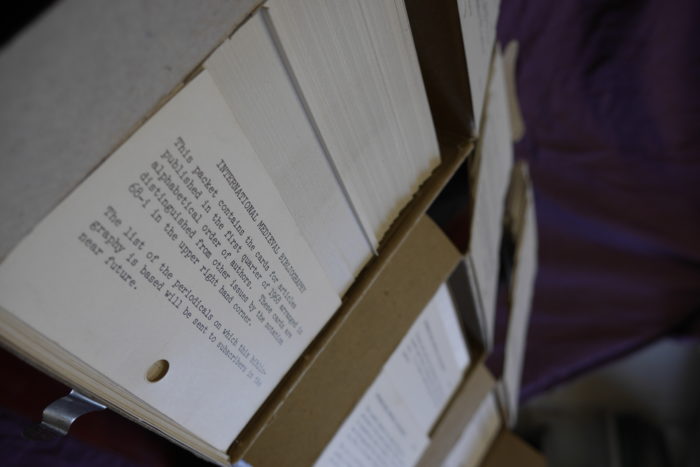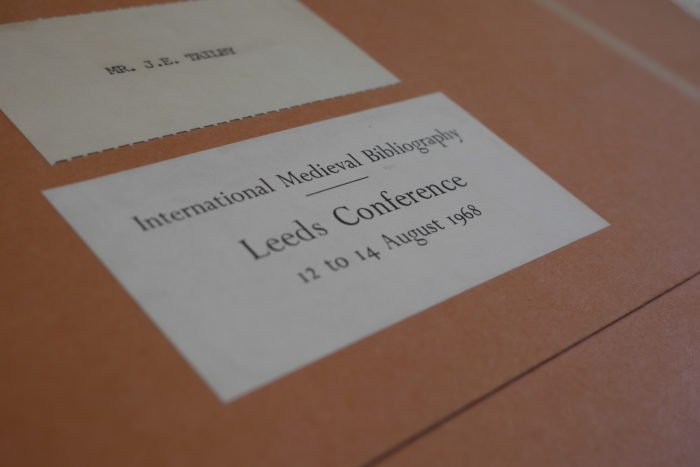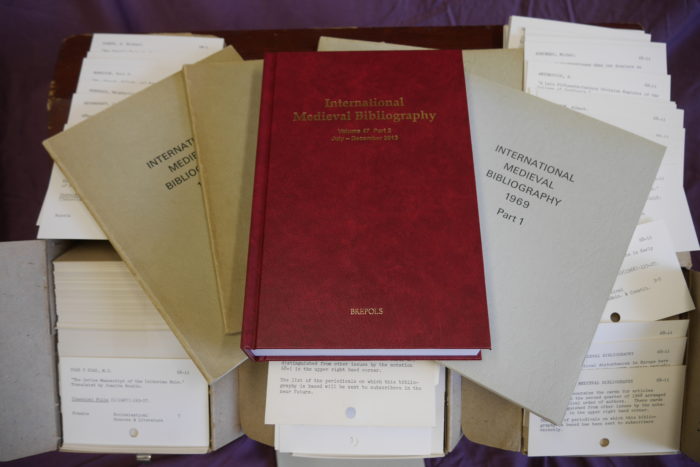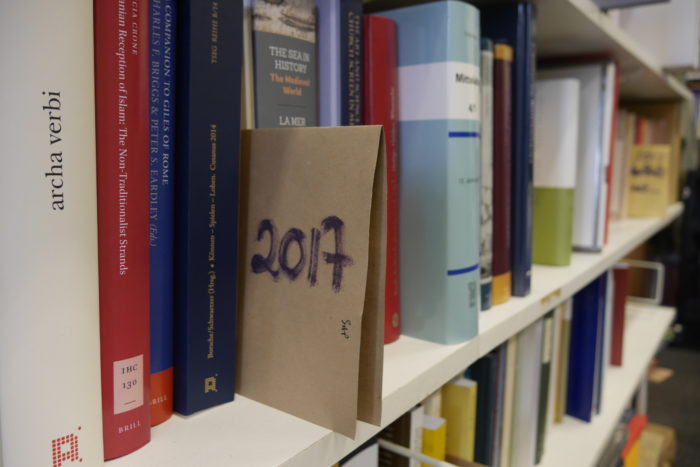History of the International Medieval Bibliography
Overview
The International Medieval Bibliography (IMB), established in 1967, is the leading interdisciplinary bibliography of the Middle Ages.

Some of the original index cards of the IMB.
The IMB is produced by an editorial team at the University of Leeds and some 30 contributors world wide. It covers periodical literature and miscellany volumes published in Europe, North America, Australasia, Brazil, Japan and South Africa.
The printed IMB appears twice a year, covering most recent publications.
Where the first annual volumes contained some three thousand records each, the latest printed volumes and the online updates contain over 16,000 records every year. And a couple of years ago the total number of records in IMB-Online passed the half million mark. So I think that over 500,000 records, fully indexed with a wide range of search functions, is a fine achievement for 50 years’ work, and I hope, a good basis for the future of Medieval Studies in Leeds and the wider world.
Dr Alan V. Murray
Editorial Director of the IMB
1967-2017
In 1966, Peter Sawyer, Lecturer in Medieval History at the University of Leeds, was invited to teach at the University of Minnesota by Stuart Hoyt, Professor of Medieval History. Sawyer and Hoyt discussed the need for an international bibliography of Medieval Studies, to catalogue the ‘growing flood’ of articles on medieval topics in academic periodicals. Sawyer and Hoyt secured funding from the University of Minnesota and the McKnight Foundation of Minnesota (backed by 3M) to launch the International Medieval Bibliography and fund it for three years.

Report of an international conference held at Devonshire Hall in 1968 to discuss bibliographical co-operation and identify ways forward for the IMB.
The first IMB was printed in 1967 as a card catalogue, using an innovative scheme of three reference points (general subject, geographical area, century range). When Sawyer returned to Leeds in 1967, the IMB moved with him.
Its first centre of operations was the top floor of his house in Headingley, a suburb of Leeds. In 1968, using a generous grant from the American Council of Learned Societies, the IMB held a conference in Leeds with a reception and dinner at Temple Newsam on 12 August.
In 1995, the IMB was digitised and published on CD, in collaboration with the publisher BREPOLS, which continues to be publishing partner of the IMB. The newest and most important format is IMB-Online, which offers a wide range of advanced searches, controlled vocabulary and metrics, with four updates every year.

The IMB in Index Card, Softcover, and Hardcover Formats.
The IMB and BREPOLS have now formed a relationship with the Bibliographie de civilisation médiévale (BCM) at the University of Poitiers, to allow both databases to be accessed through a joint interface. The IMB’s holdings of articles and collected volumes complement the BCM’s listings of monographs.
As of 2017, the IMB includes over 500,000 records and uses over 120,000 index terms, relating to countries, places, persons, and texts, manuscripts and subjects.
The work of the IMB
The International Medieval Bibliography (IMB) aims to include publications from all disciplines and languages, focusing on those which represent the newest research and which are not separately catalogued by libraries. This includes articles in periodicals and essays in conference proceedings, Festschriften, and exhibition catalogues. Currently articles in 30 named languages are indexed, including Icelandic, Hebrew, and Japanese.
The articles indexed in the IMB derive from publishers’ review copies, the holdings of the Brotherton Library, and submissions from a team of about 80 contributors from around the world. Once the books are in the IMB office (or on the electronic bookshelves), the relevant articles are read and indexed by the editorial staff based at the University of Leeds; contributors do this for those articles not available to the editorial team. All staff members and contributors are medievalists, and the indexing is done from the full text of the article rather than abstracts.

Books ready to be processed in the IMB office.
Full bibliographical details of publications covered in the IMB are highlighted in each entry. In addition, each article is given a ‘three-dimensional’ classification covering general subject (the academic discipline which best relates to its content), geographical area, and century/centuries. Each article is also given 3-8 keywords, which allow enhanced search possibilities in addition to unstructured, free searches. There are over 120,000 index terms, from the crusades to dendrochronology, from queens to tadpoles, and from abbots to pomegranates. You can find out some of the more interesting article titles below.
- Two giraffes emended
- [J.R. Morgan, ‘Two giraffes emended’, Classical Quarterly, n.s. 38 (1988), 267-269]
- Anglo-Saxon morning sickness
- [Karma Lochrie, ‘Anglo-Saxon morning sickness’, Neophilologus, 70 (1986), 316-318]
- Byzantine porridge
- [Anthony M. Bryer, ‘Byzantine porridge’, in Studies in Medieval History Presented to R.H.C. Davis, ed. by Henry Mayr-Harting and R.I. Moore (London: Hambledon, 1985), pp. 1-6]
- Fish of the fields: aubergines in the Ottoman period
- [Priscilla Mary Is¸in, ‘Fish of the fields: aubergines in the Ottoman period’, Food and History, 11 (2013), 19-34]
- Hot, fat sausages!
- [Birthe Weber, ‘Heita, feita pylsa!’, Viking: Tidsskrift for norrøn arkeologi, 44 for 1980 (1981), 91-111]

